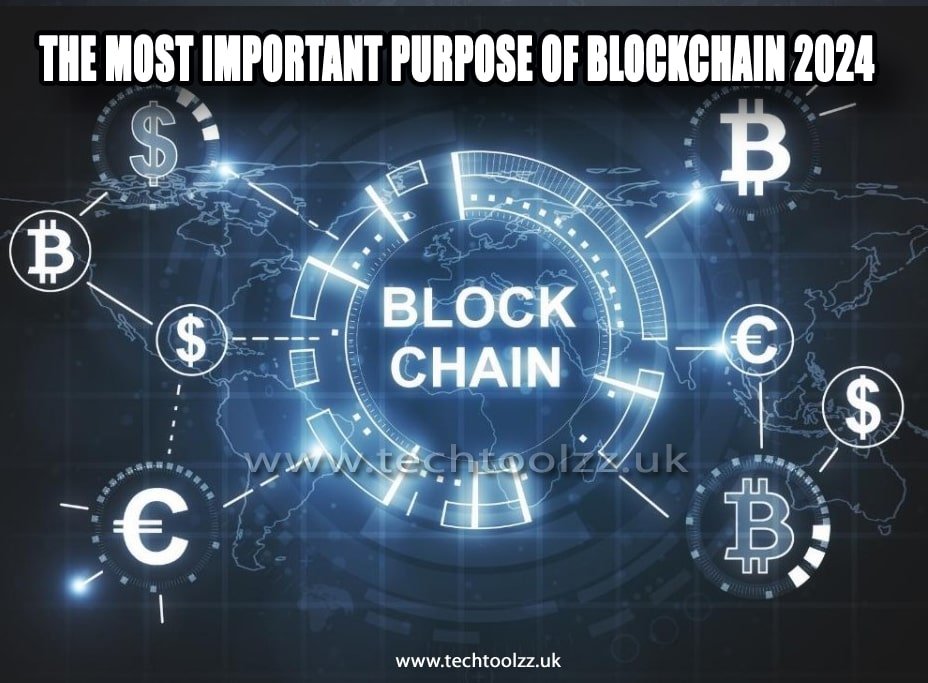The Most Important Purpose of Blockchain 2024
Table of Contents
In the quickly advancing scene of innovation, hardly any advancements have caught the creative mind, purpose and commitment to extraordinary change much like blockchain. First presented as the fundamental innovation behind Bitcoin, it has since risen above its starting points to turn into a multi-layered instrument with broad ramifications across enterprises and areas. As we enter 2024, it is basic to dig into the main motivation behind it and explain its critical job in forming the eventual fate of advanced frameworks and worldwide exchanges.
Grasping Blockchain: A Preliminary
Before taking apart its basic role in 2024, it is fundamental to comprehend the hidden standards of it. At its center, it is a decentralized disseminated record innovation that records exchanges across numerous PCs in a straightforward, carefully designed way. Every exchange is joined into a block, cryptographically connected to the past block, shaping a chain of unchanging information. This construction guarantees trust, security, and straightforwardness without the requirement for go-betweens.
Blockchain advancement past digital money
While blockchain was initially advanced as the foundation of cryptographic forms of money, its helpfulness stretches a long way past computerized monetary standards. Throughout the long term, trendsetters and industry pioneers have perceived its capability to change various fields, including finance, production network the board, medical services, land, and administration.
The main Purpose behind blockchain in 2024: Trust and straightforwardness
In 2024, the basic role of blockchain rotates around cultivating trust and straightforwardness in an undeniably advanced and associated world. This overall objective shows itself in a few key regions:
1. Supply Chain Management:
It’s changeless record gives total permeability and recognizability in supply chains, permitting partners to confirm the legitimacy and provenance of merchandise. By recording each exchange and item development, it mitigates the gamble of forging, lessens shortcomings, and increments customer certainty.
It in-store network executives have advanced essentially since its beginning. 2024 it will act as the spine for straightforward and effective production network tasks. Organizations use blockchain to follow the excursion of items from unrefined substance obtaining to assembling, circulation, and conveyance.
Shrewd agreements implanted in the blockchain consequently trigger activities given pre-characterized conditions, like delivering installment upon conveyance affirmation or starting quality checks at explicitly designated spots. This mechanization smoothes out processes, lessens mistakes, and limits the requirement for manual mediation, eventually further developing inventory network effectiveness and dependability.
2. Financial services:
In finance, it keeps on upsetting customary banking and installment frameworks by empowering quicker, more secure, and more savvy exchanges. Savvy contracts, and programmable self-executing arrangements fueled by it, smooth out complex monetary cycles like exchange repayment, credit dispensing, and resource tokenization while limiting the requirement for mediators.
It’s innovation has altered the monetary administration industry by offering uncommon degrees of safety, straightforwardness, and effectiveness. In 2024, monetary foundations are progressively taking on blockchain answers to smooth out activities, decrease costs, and further develop client experience. One of the most conspicuous uses of blockchain in finance is cross-line installments and moves.
Customary global cash moves are frequently sluggish, costly, and mistake-inclined because of the association of numerous go-betweens and heritage frameworks. Blockchain-fueled stages empower close-moment settlement of exchanges for a portion of the expense, sidestep brokers, and use digital currencies or stable coins for cross-line moves.
Furthermore, it works with consistent tokenization of resources, empowering fragmentary responsibility for world resources like land, stocks, and products. Through tokenization, financial backers can get to already illiquid resources, expand their portfolios, and take part in new speculation valuable open doors with lower obstructions to section. Savvy contracts implanted in blockchain networks mechanize the execution of venture arrangements, guarantee consistency with administrative necessities, and lessen managerial above.

3. Health care:
Blockchain holds a gigantic commitment to changing medical services information on the board and interoperability. By safely putting away persistent records, clinical preliminary information, and production network data in a dispersed record, medical care suppliers can guarantee information trustworthiness, safeguard patient protection, and work with consistent information trade across dissimilar frameworks, further developing results and decreasing managerial above.
In medical care, it innovation is driving development in information the executives, patient consideration, and clinical exploration. In 2024, medical services associations will be utilizing blockchain to make a solid and interoperable biological system for dividing delicate well-being data among patients, suppliers, guarantors, and specialists. Electronic well-being records (EHRs) put away on it networks are encoded, carefully designed, and open just to approved parties, guaranteeing patient secrecy and information security.
4. Identity Management:
In a time tormented by information breaks and data fraud, blockchain offers a decentralized character to the executives and confirmation arrangement. Independent character stages use it to give people full command over their information, empowering secure and obvious personality confirmation without depending on concentrated specialists.
The character of the executive is a basic part of computerized connections that includes validating and confirming the personality of people in various settings, including on the web exchanges, access control, and taxpayer-supported organizations. Conventional personality-the-board frameworks depend on concentrated data sets and outsider delegates to verify and approve client characters, raising worries about protection, security, and information sway.
Blockchain innovation offers a decentralized option in contrast to the customary character of the executive’s frameworks and enables people to utilize their personality arrangements. In 2024 use blockchain cryptographic standards to make advanced personalities possessed and constrained by clients themselves. Every client’s character is addressed by an extraordinary sets of cryptographic keys put away in the blockchain network, permitting them to specifically unveil individual data to outsiders without disclosing delicate information or depending on go-betweens.
5. Report and Voting:
Blockchain-based casting ballot frameworks can work on the honesty and straightforwardness of constituent cycles and relieve issues like electoral cheating, pressure, and control. By keeping votes in a sealed record, it guarantees the evidence and suitability of political decision results and advances more noteworthy confidence in fair organizations.
The respectability and authenticity of constituent cycles are fundamental for the advancement of popularity-based standards and for guaranteeing the portrayal and cooperation of residents in the administration of public issues. Be that as it may, conventional democratic frameworks are inclined to different weaknesses, including polling form altering, electoral misrepresentation, and altering. Blockchain innovation offers a decentralized and straightforward option in contrast to conventional constituent frameworks and empowers secure, irrefutable, and auditable races.
Defeating difficulties and preparing forward
Notwithstanding its colossal potential, it reception faces a few difficulties, including versatility constraints, administrative vulnerability, interoperability issues, and ecological worries connected with energy utilization. Tending to these difficulties requires a purposeful exertion by industry partners, policymakers, and technologists to drive development, layout guidelines, and encourage joint effort.
Versatility:
One of the principal challenges confronting blockchain innovation is versatility. Conventional blockchain organizations, for example, Bitcoin and Ethereum face constraints concerning exchange throughput and handling speed. As the number of clients and exchanges increment, these organizations battle to fulfill the expanded need, prompting blockage and higher exchange expenses.
To beat adaptability issues, specialists and engineers are investigating different versatility arrangements like Layer 2 conventions, sharding, and elective agreement instruments. By carrying out these arrangements, blockchain organizations can accomplish higher throughput and versatility without compromising security or decentralization.

Administrative vulnerability:
One more huge boundary to blockchain reception is administrative vulnerability. State-run administrations all over the planet are wrestling with how to successfully control blockchain and digital forms of money. While certain nations have embraced it innovation and established great guidelines to empower development and speculation, others have adopted a more careful strategy and carried out severe guidelines or by and large prohibitions on certain blockchain applications.
Administrative vulnerability obstructs to passage of blockchain new businesses and upsets development in the business. To address this difficulty, policymakers should work with industry partners to foster clear and extensive administrative systems that help development while safeguarding customers and financial backers.
Interoperability:
Interoperability alludes to the capacity of various blockchain organizations to impart and cooperate flawlessly. Right now, the blockchain environment is divided and numerous blockchain stages and conventions work in confinement. This absence of interoperability forestalls the consistent trade of resources and information between various it networks, restricting the capability of it’s innovation to accomplish its full impact.
To beat interoperability issues, industry partners are attempting to foster norms and conventions that work with interoperability between blockchain networks. By laying out normal principles for information arrangements, APIs, and correspondence conventions, it organizations can interoperate all the more effectively and open up additional opportunities for cross-chain exchanges and decentralized applications.
Ecological Worries:
One of the reactions evened out against it’s innovation is its effect on the climate, particularly with regard to energy utilization. Evidence-of-work (PoW) agreement components utilized by blockchain organizations, for example, Bitcoin and Ethereum require huge figuring power and energy consumption to confirm exchanges and secure the organization. Pundits contend that the energy utilization related to PoW agreement instruments is unreasonable and adds to fossil fuel byproducts and natural corruption.
To address ecological worries, blockchain designers are investigating elective agreement instruments like proof-of-stake (PoS) and assigned proof-of-stake (DPoS) that are more energy-proficient and damageless to the ecosystem. By changing to these agreement components, it organizations can diminish their energy utilization and alleviate ecological effects, making blockchain advancements more feasible in the long haul.
Looking forward: The future of blockchain in 2024 and then some
In spite of the moves and obstructions to reception, the future of blockchain innovation looks encouraging in 2024 and then some. As it proceeds to develop and advance, we can anticipate far reaching reception across different businesses and areas, prompting development, productivity and straightforwardness. In the monetary administrations area, blockchain-based arrangements are ready to reform installments, moves and capital business sectors, democratizing admittance to monetary administrations and advancing monetary consideration.
In production network the board, it vows to further develop discernibility, responsibility and supportability, empowering shoppers to pursue more educated buying choices and considering organizations responsible for their activities. In medical care, blockchain-based arrangements are supposed to further develop information interoperability, patient results and medical services conveyance, give patients more noteworthy command over their wellbeing information, and work with cooperative examination and advancement. In character the executives and administration, it can possibly change the manner in which we oversee and check personalities, vote in races and take part in equitable cycles, advancing more prominent trust, straightforwardness and responsibility in open foundations.

End
As we explore the intricacies of an undeniably digitized world, blockchain is ready to turn into the basic innovation that determination the following flood of financial change. By embracing its center standards of trust, straightforwardness and decentralization, we can open additional opportunities, engage people and construct a more pleasant and stronger future for a long time into the future.
In 2024 and then some, blockchain’s most significant reason lies in its capacity to cultivate trust and straightforwardness, encourage development and productivity, and engage people and associations to make positive change on the planet. As we tackle the force of blockchain innovation to address probably the most squeezing difficulties confronting mankind, we are on the way to an additional comprehensive, maintainable and prosperous future.
